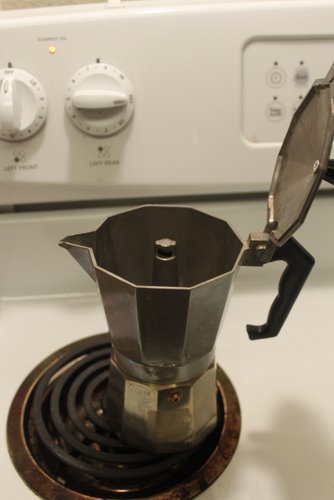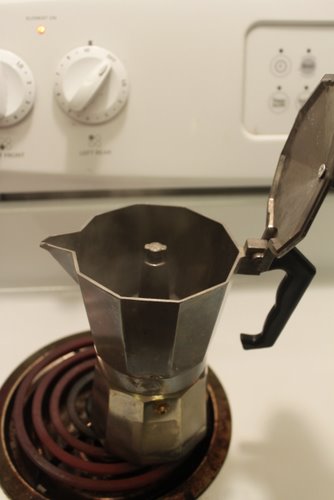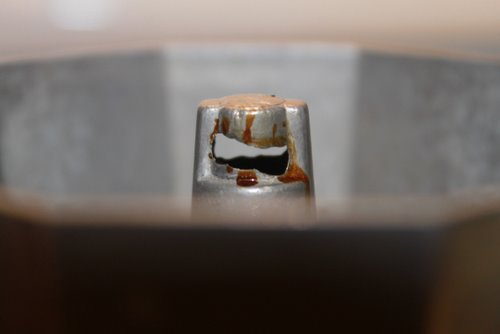The goal: make some good coffee using a moka pot
The result: a pot full of steam and not much else (story below)
For those who enjoy drinking strong coffee (espresso, anyone?), if you want something stronger than brewed coffee but don’t have the money to spend on a high-quality home espresso machine, the moka pot makes a reasonable substitute. A moka pot is sometimes called a stovetop espresso maker, even though it does not make real espresso. Although it uses steam to brew coffee, the steam is not pressed through the grounds at high enough pressure to emulsify the oils inside the coffee, a key part of the espresso-making process. Nonetheless, the coffee that comes out is very strong, which is how I prefer to drink it.
The apparatus has three parts—a water chamber on the bottom, a coffee carafe on top, and a filter pot where the coffee grounds are held, sandwiched in between. As water from the bottom chamber heats up and boils, steam pushes up through the grounds and brews the coffee, filling the upper part of the coffee maker.
Back when we lived in Boston, we used a moka pot regularly. We weren’t as aware of coffee quality in those days, but we were generally pleased with the coffee it made. Last night, we broke out our new (used) moka pot to see if we could make some good late-evening coffee. It turned out to be harder than it should have been.
Start with good coffee
No matter what method you use to make coffee, the most important thing is to start with is good coffee. We had that. Batdorf and Bronson, a coffee roaster based in Olympia, Washington, just sent me two freshly-roasted coffees to try—a single-origin from Papua New Guinea and also the company’s Holiday Blend. Our plan was to brew some of the Papua New Guinea coffee with the moka pot.
Add water
We looked to Stumptown’s online brewing guide for some tips on how to best use the moka pot. The most important tip was to fill the water chamber with hot water instead of cold. When you do this, the heat from the burner does not cook the grounds before the water gets hot. We were also advised to pull the pot from the heat when the coffee coming out the tower was about the color of honey. That seemed easy enough, so we set to work making the coffee. Shayna ground the beans and filled the carafe with hot water. She set the pot on the stove (medium heat)with the lid open, so we could watch the coffee as it brewed. If the smell of the fresh grounds was any indication, the coffee was going to be tasty.

Our gustatory pleasure was not forthcoming, however.
And wait….
As we sat there watching the pot with anticipation, the coffee seemed in no hurry to come out. Since the water was hot when we put it in, the pot should have begun bubbling out coffee pretty quickly. The water did boil (we could hear it gurgling in the chamber beneath the grounds) but nothing happened. No coffee came up the spout.
Maybe it just needs a little more time, we thought. We waited another minute or two to see what would happen. Still nothing.
Maybe it needs just a little more heat. We turned the burner up to high and waited some more. Same result.

Maybe next time
By this time, the kitchen was filling up with the smell of singed coffee, sweet and burnt. The heavy odor nearly pushed us out of the kitchen, and soon we conceded we were not going to get any coffee, pulling the pot off the burner.

It took a while to figure out why the pot didn’t work, and I’m still not 100% sure. The spout where the coffee should have come out was worn, but that should not have prevented the coffee from brewing. A little online investigation led us to the conclusion that the seal between the water chamber and the top half of the pot was probably the culprit. Even though it looked okay, it must have been letting steam escape out the sides of the pot instead of pushing up through the grounds.

Not to be denied
Thwarted in our effort to make moka coffee but still craving something to sip, we broke out the French press and brewed a batch. The coffee was a bit fruity, with some walnut flavors too. It had a full mouthfeel and was evenly balanced. The flavors were vibrant and it was obvious the coffee was high quality.
While we enjoyed the coffee, it was a shame that we could not try it with the moka pot too. I’ll have to get a new seal and try again.
Our lesson for the evening was that “you get what you pay for.” We had bought the moka pot at Goodwill for a couple dollars and all we got was a couple drips of burned coffee. Oh well, next time…